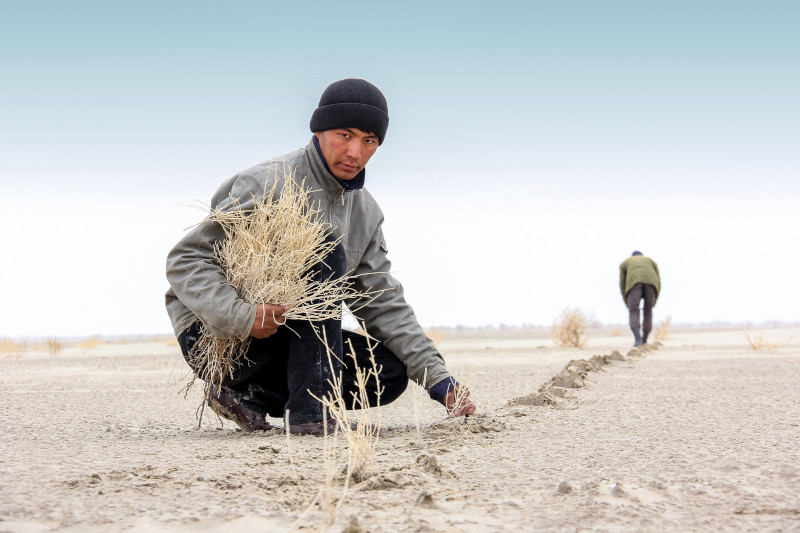Transforming land degradation: what are we waiting for?
May 9, 2022

Fifty years ago the authors of the Limits to Growth suggested that trends in unchecked human population growth, pollution, and damaging agricultural practices would likely collide around 2030, leading to widespread food collapses. The recently launched second edition of the “Global Land Outlook”--a stocktake of the world’s land--revealed that this is well on track. We have already transformed more than 70 percent of our planet’s land area, and one out of every five hectares of land, including about half of the world’s agricultural soils, are already degraded. Recent headlines from around the world, from China to Brazil to the Caribbean, foretell the same future, especially when climate-induced heat waves, droughts, floods, and insect collapses are factored in. We are headed toward nothing short of an existential crisis. The report calls for a global crisis footing on land restoration, stating that “at no other point in modern history has humanity faced such an array of familiar and unfamiliar risks and hazards.”
First the bad news: our land degradation crisis requires fundamental societal transformations in our economy, laws, policies, and agricultural practices. This means upending decades-old long-entrenched systems that are supported by status-quo politicians and special corporate interests who are often resistant to change. For example, the world spends US$540 billion in agricultural subsidies, of which 87 percent is harmful to nature and human health, and which largely benefits the one percent of agribusiness farmers who control more than 70 percent of all agricultural lands, rather than the world’s 500 million smallholder farmers. Changing entrenched systems is hard work. But now the good news: at least three profound transformations cited in the Global Land Outlook are already underway.
Improved land governance and tenure security
Land rights and land tenure--the right to own, use and control land--is essential for smallholder farmers and communities if they are to invest in restorative and regenerative land management. Of particular importance are the rights of the more than 500 million pastoralists, and the land rights of 476 million Indigenous peoples, who account for six percent of global population, but who act as stewards over about a quarter of the earth’s terrestrial surface. The Global Land Report cites that inequality in land rights continues to increase around the world. For this reason, the UNDP-led Equator Initiative places special emphasis on awarding the prestigious Equator Prize to local communities who have succeeded, against the odds, in securing land rights in Indonesia, Canada and Ecuador, among many other communities.
Regenerative land use
Regenerative land use, the transition from business-as-usual land management practices accounts for about a third of climate emissions, but regenerative agriculture and agroforestry could provide about a third of our climate emissions solution. For this reason UNDP provides funding, through its Small Grants Programme, to farmers in Kenya, Mexico and around the world, to help farmers transition to regenerative agricultural practices. Transitions to regenerative agriculture and agroforestry can have profound impacts on the lives of farmers, such as the 2,700 women in India’s Deccan Development Society, the more than 1,000 farmers in Kyrgyzstan’s BIO-KG Federation of Organic Development, and the 500 women practicing cocoa agroforestry in Cameroon’s Tropical Forest and Rural Development initiative.
Integrated land use planning
Integrated land use planning--the use of spatial planning and multi-sectoral approaches--is essential to develop nature-positive land use plans and identify spaces where land protection, restoration and sustainable management are required to meet societal goals. UNDP’s “Map of Hope”, now piloted in 14 countries, convenes multiple sectors and spatial data sets through its UN Biodiversity Lab, to help governments develop their own “Map of Hope” land use plan. Countries such as Haiti, Cambodia, Uganda and South Africa, are already discovering that this provides a road map for implementing the types of measures outlined in the Global Land Outlook.
Now for two bits of even better news. The first is that according to the report, the cost of action of restoration about US$300 billion annually, could be fully financed by repurposing existing harmful agricultural subsidies, would provide between seven and 30 times return on investment, could provide up to a third of our climate solution, would profoundly benefit more than three billion people, and would change our food security trajectory for the coming decades. The second bit of good news is that the transformative pathways for land outlined in the Global Land Outlook represent societal choices. We are not locked into the grim trajectory portrayed by the Limits to Growth for the next 50 years. Rather, we have the ability and agency to choose a better future for humanity and the planet by embracing and scaling up the transformational pathways already underway. The only question remaining is: what are we waiting for?

 Locations
Locations